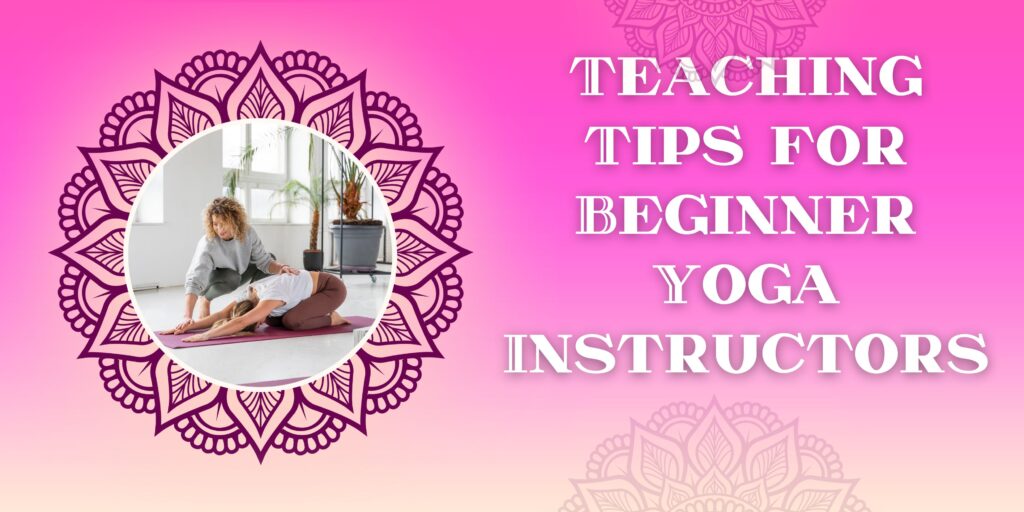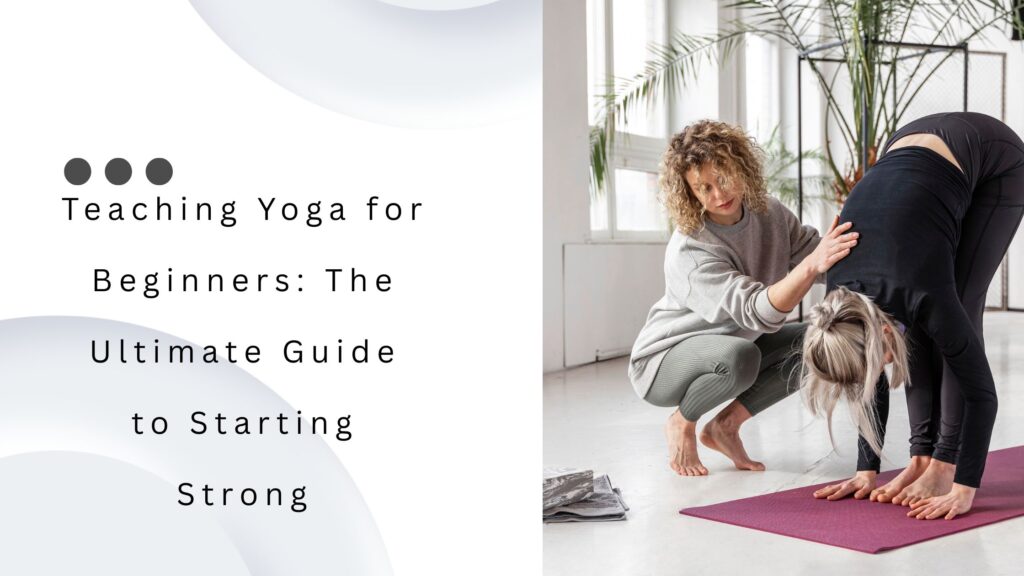Yoga is one of the most powerful tools for physical, mental, and emotional well-being. With millions of people across the globe embracing yoga for health, stress relief, and inner peace, there’s a growing need for compassionate and knowledgeable instructors. If you’re a yoga teacher (or aspiring to be one), teaching yoga for beginners can be both incredibly rewarding and deeply transformative—not just for your students, but for yourself as well.
In this comprehensive guide, we’ll walk you through everything you need to know about teaching yoga to beginners, including strategies, best practices, foundational poses, and essential tools to ensure your students feel safe, inspired, and motivated on the mat.
Teaching yoga means leading students through physical postures, breathing techniques, and meditation, while fostering a nurturing environment that encourages self-exploration. Yoga instructors employ strategies such as clear communication and explaining the context of each pose to help students grasp the purpose and benefits of their practice. Successful instruction also requires knowledge of yoga philosophy and human anatomy, as well as the ability to adapt guidance to suit varying skill levels and individual needs.
Table of Contents
Why Focus on Teaching Yoga for Beginners?
Most people stepping into a yoga studio or joining an online class are brand new to yoga. Their bodies may be tight, their minds full of self-doubt, and they might carry limiting beliefs like “I’m not flexible enough for yoga.”
By focusing on teaching beginners, you play a pivotal role in shaping their yoga journey. You’re the first guide who introduces them not just to physical postures, but to a new way of being. This early impression can determine whether they fall in love with yoga—or never come back after a single class.
Let’s dive into how to teach yoga to beginners in a way that is empowering, safe, and engaging.
Understanding the Beginner’s Mindset
When you’re teaching yoga for beginners, empathy is your superpower. Most new students come with a mix of curiosity and anxiety. They may fear being judged, injured, or left behind in a fast-paced class.
Common Beginner Concerns:
- “What if I can’t do the poses?”
- “Will I look silly?”
- “Am I too old/overweight/stiff for yoga?”
- “I can’t even touch my toes!”
Your job is to create a nurturing space where all of these fears can dissolve. Remind your students that yoga isn’t about performance or perfection—it’s about presence, breath, and personal growth.
Creating a Safe and Welcoming Environment
Creating a positive environment starts before the class even begins. When teaching yoga to beginners, focus on:
- Warm greetings and introductions
- Explaining that yoga is non-competitive
- Offering reassurance that modifications are encouraged
- Emphasizing the importance of listening to their bodies
Use clear, friendly, and inclusive language. Avoid technical jargon and don’t assume your students know yoga terminology. If you say “Downward Dog,” follow it with a short explanation.
Essential Principles for Teaching Yoga for Beginners
Here are some core teaching principles to keep your classes engaging, effective, and safe:
1. Simplicity is Key
Avoid complex sequences. Stick to basic poses and transitions. Repetition helps students build muscle memory and confidence.
2. Clear Instructions
Use simple, direct cues like:
- “Lift your arms overhead”
- “Breathe in as you stretch”
- “Exhale slowly as you fold forward”
Avoid overloading with too many details at once.
3. Focus on Breath Awareness
Breathing is the heart of yoga. Teach basic pranayama (breath control) like deep belly breathing, Ujjayi breath, or Nadi Shodhana (alternate nostril breathing) to anchor students in the present moment.
4. Offer Modifications
Introduce props like blocks, straps, and blankets. Demonstrate pose variations for different body types and levels of flexibility. This makes yoga accessible for seniors, beginners, and those recovering from injury.
Basic Class Structure for Beginners
When creating a beginner-friendly yoga class sequence, aim for a flow that builds gradually, avoiding sudden or intense transitions.
Typical Beginner Yoga Class Layout:
- Centering and Breathwork (5 minutes)
- Gentle Warm-Up (10 minutes)
- Standing Poses (15 minutes)
- Seated and Supine Poses (15 minutes)
- Cool Down and Savasana (5-10 minutes)
Keep the pace slow and steady. Demonstrate each pose first, then walk around to observe and assist as needed.
Foundational Yoga Poses for Beginners
When teaching yoga for beginners, focus on a small set of foundational asanas that help build strength, flexibility, and body awareness.
Top Beginner Yoga Poses:
- Tadasana (Mountain Pose) – Postural awareness and grounding
- Balasana (Child’s Pose) – Rest and introspection
- Marjaryasana/Bitilasana (Cat-Cow) – Spinal mobility
- Adho Mukha Svanasana (Downward Dog) – Strengthens upper body and stretches hamstrings
- Virabhadrasana I & II (Warrior I & II) – Builds strength and balance
- Paschimottanasana (Seated Forward Fold) – Hamstring and back release
- Setu Bandhasana (Bridge Pose) – Gentle backbend and core strength
Always cue alignment points, encourage use of props, and emphasize breath awareness over how “deep” someone gets into a pose.
| Section | Focus Area | Examples / Notes |
| Introduction | Purpose & Benefits of Beginner Yoga Teaching | Shapes first yoga experiences, empowers students, builds foundational understanding |
| Beginner’s Mindset | Addressing fears, building confidence | “I’m not flexible,” “I’ll look silly” – teacher reassures, guides, empowers |
| Safe Environment | Inclusive, supportive, non-judgmental setting | Friendly greetings, use of props, zero pressure, trauma-sensitive language |
| Core Teaching Principles | Simplicity, clarity, modifications, breath awareness | Use clear cues, demonstrate slowly, explain poses in layman’s terms |
| Class Structure | Recommended sequence for beginners | Centering → Warm-up → Standing poses → Seated/Floor poses → Savasana |
| Foundational Poses | Key beginner-friendly asanas | Tadasana, Child’s Pose, Cat-Cow, Downward Dog, Warrior I & II, Forward Fold, Bridge |
| Breathwork & Meditation | Simple, calming breath techniques and short meditations | Deep belly breathing, Ujjayi, Nadi Shodhana, 2-3 min mindfulness practice |
| Teaching Tips | Practical techniques for new instructors | Face students, repeat cues, observe, provide encouragement and feedback |
| Mistakes to Avoid | Common beginner-teacher pitfalls | Fast pacing, complex poses, no props, too much Sanskrit or pressure |
| Inclusivity | Making yoga accessible and empowering for all | Body-positive cues, chair options, size & age diversity, inclusive mindset |
| Resources & Tools | Supportive materials and continuing education | Yoga props, beginner yoga books, online teaching platforms, workshops |
| Final Thoughts | Role of teacher in transformation | Compassion over complexity, empower students, honor each journey |
Teaching Breathwork and Meditation to Beginners
Many beginners feel overwhelmed by the idea of meditation. Keep it approachable:
- Start with 2–3 minutes of guided breathing
- Use analogies like “imagine inflating a balloon in your belly”
- Avoid abstract or esoteric language
- Guide them to focus on breath, sounds, or body sensations
Introduce simple pranayama techniques:
- Diaphragmatic Breathing
- Box Breathing (Inhale-Hold-Exhale-Hold)
- Nadi Shodhana (Alternate Nostril Breathing)
A few minutes of meditation or breathwork at the beginning or end of class can help students feel calm, centered, and open to the experience.
Read More: Restorative Yoga: A Path to Deep Relaxation and Healing
Read More: Ayurvedic Diet for Yoga: A Complete Guide to Nourishing Body, Mind, and Spirit

Teaching Tips for Beginner Yoga Instructors
Here are some practical strategies to elevate your teaching:
- Mirror the students: Face them during demonstrations so left and right are easier to follow.
- Repeat cues: Repetition reinforces learning.
- Observe: Walk around to offer guidance and encourage proper form.
- Ask for feedback: Understand what students liked or found challenging.
- Offer encouragement: Celebrate effort over perfection.
When in doubt, teach less and observe more. Let the students’ energy guide you.
Common Mistakes to Avoid When Teaching Yoga for Beginners
Even experienced teachers can fall into these traps:
- Moving too fast: Beginners need more time in each pose.
- Using too much Sanskrit: This can confuse or alienate students.
- Skipping warm-ups or cool-downs: Essential for injury prevention and integration.
- Pushing students too hard: Always respect physical boundaries.
Your role is not to impress but to empower.
Inclusivity and Accessibility in Beginner Yoga Classes
Modern yoga is for everybody, regardless of size, age, gender, or background. When teaching yoga for beginners, embrace a trauma-informed, body-positive, and inclusive approach.
- Avoid body-shaming language (e.g., “burn fat” or “flatten the belly”).
- Offer chairs or wall support for those with mobility challenges.
- Normalize the use of props as a sign of wisdom, not weakness.
- Invite students to rest at any time without shame.
Inclusivity isn’t a trend—it’s the foundation of a safe and supportive yoga experience.
Resources for Teaching Yoga for Beginners
Recommended Tools & Materials:
- Yoga mats, blocks, straps, bolsters
- Beginner yoga books (e.g., The Heart of Yoga by T.K.V. Desikachar)
- Online teaching platforms for virtual classes
- Anatomy and alignment workshops
- Continuing education from Yoga Alliance
Stay curious, keep learning, and regularly review your beginner teaching methods to reflect feedback and your own growth.
Final Thoughts: Make a Lasting Impact
Teaching yoga for beginners is one of the most fulfilling journeys you can take as a yoga teacher. You have the unique privilege of introducing someone to a practice that could change their life—physically, mentally, and spiritually.
Approach your teaching with empathy, structure your classes thoughtfully, and stay grounded in the principles of breath, presence, and personal transformation. When you do, you’re not just leading a yoga class—you’re holding space for personal evolution.
Get Started Today
Whether you’re leading your first class or refining your current teaching approach, remember this:
“The best yoga teacher is not the one who shows off the most advanced poses, but the one who makes beginners feel like they belong on the mat.”
So, roll out your mat, open your heart, and begin teaching yoga for beginners with compassion and purpose. The journey starts with you.
FAQ:
Q. What is the best way to start teaching yoga for beginners?
Ans: The best way to start teaching yoga for beginners is to create a welcoming and non-intimidating environment. Focus on simple sequences, foundational yoga poses, clear verbal cues, and plenty of modifications. Prioritize breath awareness and ensure that every student feels supported and empowered, regardless of their experience or flexibility level.
Q. Which yoga poses should I include in a beginner class?
Ans: When teaching yoga for beginners, stick to foundational poses such as:
• Tadasana (Mountain Pose)
• Child’s Pose (Balasana)
• Cat-Cow (Marjaryasana-Bitilasana)
• Downward Dog (Adho Mukha Svanasana)
• Warrior I and II (Virabhadrasana I & II)
• Seated Forward Fold (Paschimottanasana)
• Bridge Pose (Setu Bandhasana)
These poses build strength, flexibility, and confidence in new students.
Q. How long should a beginner yoga class be?
Ans: A beginner yoga class typically lasts between 45 to 60 minutes. This gives enough time to include centering, warm-up, key poses, gentle transitions, and a relaxing savasana. Keeping the pace slow and steady helps beginners build body awareness and stay engaged without feeling overwhelmed.
Q. How do I make my yoga classes more inclusive for beginners?
Ans: To make your yoga classes inclusive:
• Use body-positive and non-judgmental language
• Offer props and pose variations
• Avoid pressure to perform or “keep up”
• Encourage rest at any time
• Teach with a trauma-informed, culturally sensitive approach
Inclusivity ensures every student, regardless of age, size, background, or ability, feels safe and seen.
Q. What are the most important teaching tips for yoga instructors working with beginners?
Ans: Top tips include:
• Keep instructions simple and repeat essential cues
• Demonstrate poses clearly and face the students
• Observe and adjust your pacing based on class energy
• Emphasize breathwork and mindfulness
• Offer encouragement over correction
Teaching yoga for beginners is about creating trust and inspiring curiosity—more than mastering advanced poses.
Q. How to teach yoga for beginners step by step?
Ans: 1. Share only one philosophical theme per class.
2. Begin by teaching proper breathing techniques.
3. Limit the class duration to 60 minutes.
4. Minimize demonstrations to encourage inner awareness early on.
5. Keep savasana brief and provide guided instruction.
Q. What to teach in a beginner yoga class?
Ans: Introducing asana to beginners can feel overwhelming, but it’s essential not to overlook the more subtle elements of yoga practice. Even in a beginner’s class, aspects like meditation, breathwork, and yogic philosophy can and should be introduced, explored, and practiced.
Q. How to get started teaching yoga?
Ans: Steps to become a yoga instructor:
1. Study and practice yoga.
2. Complete a yoga teacher training program.
3. Register with a recognized organization.
4. Obtain CPR certification.
5. Choose your area of focus as a yoga teacher.
6. Start leading yoga classes.
7. Keep your certifications up to date.
Q. How to explain yoga to beginners?
Ans: Yoga isn’t about achieving extreme flexibility or twisting your body into complex shapes. It’s about mindful breathing, discovering inner strength through meditation, and building freedom in the body with foundational poses. It really is that straightforward.
Declaration Note:
We use third-party videos and images on https://yogavidhi.com/ for educational and illustrative purposes. All rights belong to their respective owners. No copyright infringement is intended.



